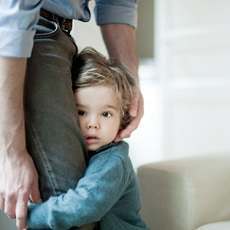
Anxiety and Anxiety Disorders in Children
Anxiety, like many other emotions, is closely linked to our fears. Children experience a number of fears from the moment they are born. How they react to that fear — whether it be fear of the dark, ghosts, insects or dogs, depends on the child’s personality, age, genetic disposition, and coping skills.
Generally, as children grow up, fears lessen. Fears become a problem only if they prevent the child from performing normal activities. Intervention or treatment may be considered at this point.
Anxiety Symptoms
Children experience anxiety at different stages and ages. Below are some common anxiety symptoms and how parents can help them cope:
When feeling panicked, infants can become irritable, restless and lose sleep. Indications of anxiety at this tender age can include:
- Clinging
- Crying endlessly
- Throwing tantrums
- Sleeplessness
- Inability to sleep alone
- Urinating often
You may be able to gradually reduce anxiety in very young children by exposing them to a wide variety of experiences:
- Having them meet many different people outside the home and encouraging them to play with other children
- Allowing them to make their own decisions
- Setting a regular bed time routine and training them to fall asleep on their own
Overly stressed parents pass along their own stresses to their children, so make every attempt to keep a happy environment in the home.
Anxiety in school children can include:
- Shyness
- Timidness
- Clinging to parents
- An inability to interact with other children
- Lack of concentration
- Poor memory
- Withdrawal
- Pessimism
- Constant complaints of head/stomach aches
Such children can be demanding and irritable. They require a lot of patience. It’s important to be assertive, but calm when helping them deal with the things they are anxious about. Reassure them whenever you can.
Teenagers
As they undergo hormonal, physical, and emotional changes, teens exhibit stress and anxiety by:
- Over/under eating
- Excessive sleep
- Obsession with appearance
- Defying authority
It’s critical to set reasonable ground rules with adolescents without being overly restrictive. Encourage them to share their concerns and worries so they feel safe confiding in you.
Reasons For Anxiety
- Conflicts or changes in the family: A parental argument, divorce, or illness can be extremely upsetting for children. They may start taking on the guilt for their family woes. Both overly controlling and extremely liberal parents can pave the way for anxiety in a child.
- Physical illness or disabilities: Ailments such as severe asthma as well as reactions and taunts from other children can make an ill or disabled child self-conscious, upset and depressed.
- Tight schedules: Jam packed days filled with too many activities may stress the child and deprive them of needed downtime. All children need free, unstructured time to themselves every now and then.
- Issues at school: Bullying, name calling, teasing, harsh or unfair teachers, and overly burdened school work can make a child depressed and resentful. This may result in a lack of self confidence or cause them to lose interest in school and other activities.
- Fears/phobias: Exposure to frightening incidents, sad and terrible news, violent/horror movies, upsetting or gory books and stories can cause fears in children. If they have experienced bad episodes in the past, some children may develop a fear of social situations, schools, or open spaces (agoraphobia). They may start to develop obsessions, or in extreme cases, severe depression may include self-harming behaviors or suicidal thoughts.
How to Avoid Anxiety
Communication, comfort, and care are the most important factors that can help a child feel safe, loved, and cared for. Provide reassurance while enabling them to express their fears.
Show support and love with physical contact – hugging, cuddling, holding, and rocking the child. As you soothe them, reassure them with comforting and calming words. Allow the child to express him or herself freely -without judgement about their concerns, worries and fears.
Encourage children to solve their own problems instead of stepping in to fix them. This fosters independence and courage in fearful situations, while discouraging negative and unproductive thoughts.
Respect and support the child’s feelings when it matters the most. Seek medical guidance if the fears and phobias become so overwhelming that it keeps the child from pursuing normal, everyday activities.
TOP 5
ANXIETYTreatments |
|||||
| AnxiClear | Exulin | Hapinex | MindSoothe | ReloraMax | |
|---|---|---|---|---|---|
| 1 | 2 | 3 | 4 | 5 | |
| Overall Rating | 99.50% | 87.30% | 82.10% | 76.80% | 72.80% |
| Performance* |





|





|





|





|





|
| Speed of Results* | Extremely Fast | Good | Good | Average | Average |
| Quality of Ingredients | Premium | Good | Good | Average | Unknown |
| Customer Satisfaction Evaluation | 99.40% | 85.30% | 80% | 74% | 70.30% |
| Safety Evaluation | Safe for Use | Safe for Use | Safe for Use | Safe for Use | Safe for Use |
| Customer Service Rating |





|





|





|





|





|
| Reorder Rate | Highest | Good | Average | Average | Average |
| Return Policy | Risk Free | Unopened | Unclear | Good | Risk Free |
| Success Rate* | 99.40% | 86.20% | 81% | 74.50% | 69% |

 Subscribe Now
Subscribe Now













